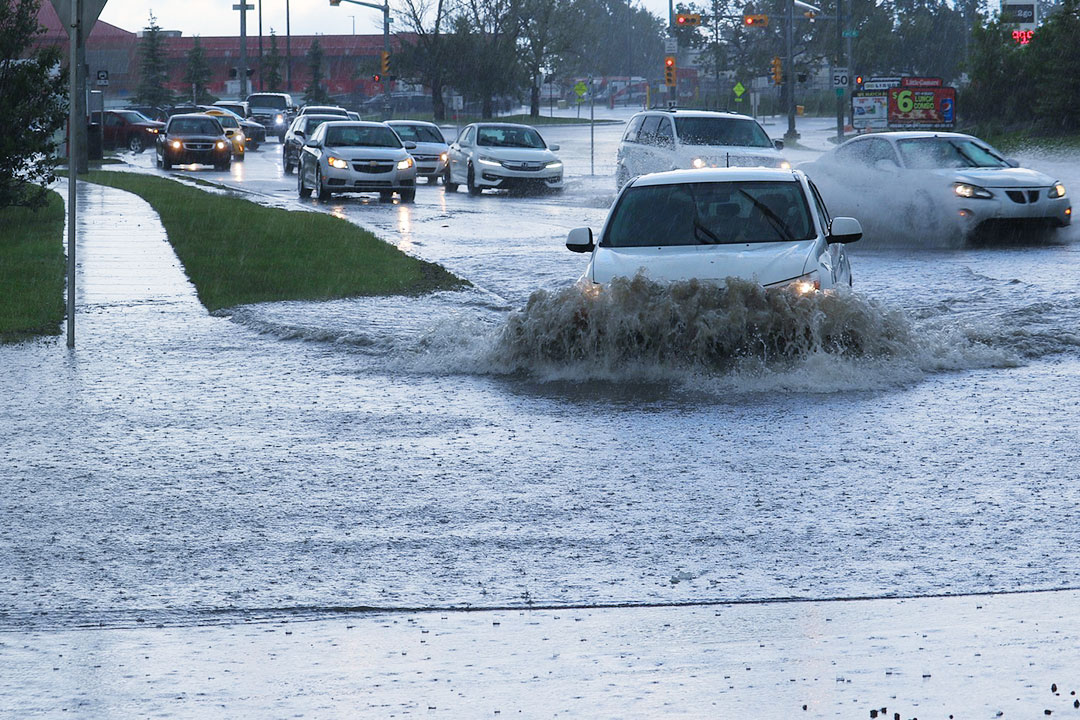Flash Flood Emergency: Causes, Impacts, And Mitigation Strategies

Table of Contents
Causes of Flash Floods
Several factors contribute to the occurrence of flash flood emergencies. Understanding these causes is crucial for implementing effective prevention and mitigation measures.
Intense Rainfall
Intense precipitation is the most common cause of flash floods. Torrential rain, falling at rates exceeding the capacity of drainage systems, leads to rapid water accumulation and overflowing waterways.
- Typical rainfall amounts associated with flash floods can vary depending on location and geographical factors, but often exceed 2 inches (5 cm) in an hour or 3-6 inches (7.5-15 cm) in a few hours.
- Soil saturation plays a significant role. When the ground is already saturated from previous rainfall, it cannot absorb additional water, leading to increased surface runoff.
- Impervious surfaces, such as roads, buildings, and parking lots, prevent water infiltration into the ground, further contributing to rapid runoff and increasing the risk of rainfall intensity leading to flash flood events.
Dam Failures
The catastrophic failure of dams can trigger devastating flash floods downstream. The sudden release of massive volumes of water overwhelms natural and artificial drainage systems, resulting in widespread destruction.
- Historical examples include the Johnstown Flood of 1889 and the Teton Dam failure in 1976, highlighting the devastating consequences of dam breaks.
- Factors contributing to dam failures include poor maintenance, aging infrastructure, inadequate design, and extreme hydrological events.
- The downstream impact can be catastrophic, affecting communities, infrastructure, and the environment for miles. Levee failures can exacerbate the effects.
Melting Snow and Ice
Rapid snowmelt, particularly during spring thaws or periods of unusually warm weather, can significantly contribute to flash flood emergencies. This is especially true in mountainous regions or areas with extensive snowpack.
- Geographical areas with high altitudes and significant snowfall are particularly prone to snowmelt flooding.
- Unusual warm spells or rapid temperature increases can accelerate snowmelt, overwhelming drainage systems and causing rapid river rises.
- Clogged drainage systems, due to debris or ice jams, can further exacerbate the problem, leading to ice jam flooding.
Urbanization
Increased urbanization significantly alters the natural hydrological cycle, increasing the vulnerability to flash floods. The widespread use of impervious surfaces reduces water infiltration and increases surface runoff.
- Impervious surfaces such as concrete and asphalt prevent rainwater from seeping into the ground, leading to a dramatic increase in urban runoff.
- Inadequate drainage infrastructure in rapidly developing urban areas often struggles to cope with increased stormwater volumes.
- Urbanization disrupts natural water flow patterns, reducing the capacity of rivers and streams to accommodate increased water levels, thereby heightening the risk of urban flooding.
Impacts of Flash Flood Emergencies
Flash flood emergencies have far-reaching consequences, impacting human lives, property, and the environment.
Loss of Life and Injury
The sudden nature of flash floods often leaves little time for evacuation, resulting in significant loss of life and injuries.
- Statistics consistently show a high number of fatalities and injuries associated with flash floods globally.
- Vulnerable populations, including the elderly, children, and people with disabilities, are at particularly high risk.
- Beyond the immediate physical impact, flood events can have severe psychological consequences for survivors, leading to trauma and long-term mental health issues.
Property Damage
Flash floods cause extensive damage to buildings, infrastructure, and personal belongings. The economic losses can be staggering.
- Water damage, structural damage, and the destruction of personal possessions are common consequences of flash floods.
- Businesses and communities can suffer significant economic losses, impacting livelihoods and recovery efforts.
- Infrastructure damage, including roads, bridges, and utilities, can disrupt transportation, communication, and essential services for extended periods.
Environmental Impacts
The environmental consequences of flash floods are significant, including water pollution and habitat destruction.
- Flash floods can contaminate water sources with sewage, industrial waste, and agricultural runoff, posing risks to human health and aquatic ecosystems.
- Erosion and sediment transport can drastically alter landscapes, damaging habitats and disrupting ecological processes.
- The impact on wildlife can be severe, leading to loss of life, habitat destruction, and disruption of food chains.
Mitigation Strategies for Flash Flood Emergencies
Effective mitigation strategies are essential to reduce the devastating impacts of flash flood emergencies.
Early Warning Systems
Implementing effective early warning systems is crucial for reducing casualties and property damage.
- Robust weather forecasting and monitoring systems are vital for providing timely flood alerts.
- A range of warning systems, from weather alerts delivered through various media to sirens and public address systems, are essential.
- Community outreach programs play a critical role in educating the public about flash flood risks and disseminating warnings effectively.
Land Use Planning
Careful land use planning plays a vital role in minimizing flood risk.
- Restricting development in floodplains and implementing floodplain zoning regulations are critical steps.
- Green infrastructure initiatives, such as permeable pavements and green roofs, can help manage stormwater and reduce runoff.
- Sustainable urban development practices should prioritize the integration of nature-based solutions to minimize flood risks.
Improved Drainage Infrastructure
Investing in and maintaining adequate drainage infrastructure is essential for managing stormwater effectively.
- Upgrading existing drainage systems, particularly in urban areas, is crucial for coping with increased rainfall volumes.
- Constructing new drainage channels and storm water retention basins can help mitigate flood risks.
- Implementing rainwater harvesting techniques can reduce the burden on drainage systems and provide a valuable water resource.
Community Education and Preparedness
Community education and preparedness plans are critical for ensuring effective response and minimizing loss.
- Public awareness campaigns can raise community understanding of flash flood risks and safety measures.
- Developing and practicing evacuation plans are crucial for ensuring the safety of residents.
- Fostering community participation in disaster response efforts enhances preparedness and resilience.
Conclusion
Flash flood emergencies are a serious threat, with devastating impacts stemming from intense rainfall, dam failures, snowmelt, and urbanization. Understanding the causes, along with the potential for loss of life, property damage, and environmental consequences, highlights the urgent need for proactive mitigation strategies. By implementing early warning systems, improving land use planning, upgrading drainage infrastructure, and fostering community preparedness, we can significantly reduce the devastating effects of flash floods. Prepare for flash floods by understanding the risks in your area, developing a family emergency plan, and taking steps to protect your home. Learn more about flash flood safety and how to mitigate flash flood hazards in your community – your proactive actions can make the difference between survival and significant loss.

Featured Posts
-
 Berikut Jadwal Tayang Moto Gp Argentina 2025 Di Trans7
May 26, 2025
Berikut Jadwal Tayang Moto Gp Argentina 2025 Di Trans7
May 26, 2025 -
 Fujifilm X Half Camera A Hands On Experience Fun Fresh And Whimsical
May 26, 2025
Fujifilm X Half Camera A Hands On Experience Fun Fresh And Whimsical
May 26, 2025 -
 Section 230 And Banned Chemicals A Judges Decision On E Bay Listings
May 26, 2025
Section 230 And Banned Chemicals A Judges Decision On E Bay Listings
May 26, 2025 -
 Wrongful Glasgow Airport Arrest Feature Film In The Works
May 26, 2025
Wrongful Glasgow Airport Arrest Feature Film In The Works
May 26, 2025 -
 Fotografii Naomi Kempbell V Chest 55 Letiya
May 26, 2025
Fotografii Naomi Kempbell V Chest 55 Letiya
May 26, 2025
